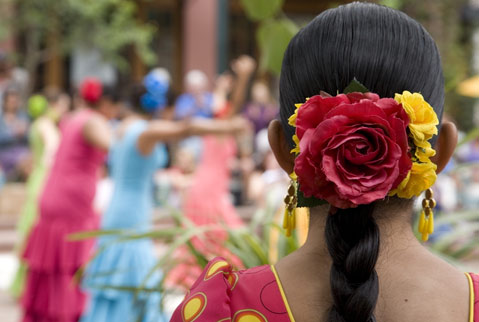Documenting the Dance
Filmmakers Follow Fiesta Dancers from Linda Vega’s Studio to Create Polka Dot Alley

An elaborate dress whose layers of ruffles taper to a train, the bata de cola adds much flair to the traditional Spanish dances being taught by instructor Linda Vega. As her young performers flounce across the white-walled room in graceful formation to prepare for their annual Old Spanish Days performances, the colorful gowns trail on the floor behind their elaborate footwork, stirring up the Fiesta spirits of yesteryear — and quite a bit of dust.
As Vega playfully cleans up the floor, doing an impromptu dance with a Swiffer mop, documentary filmmakers Christine Mallet and Randal Kazarian capture every move from inside the mirrored studio. As the girls rhythmically pound their red and powder blue shoes to the beat, the cameras don’t make them nervous—they don’t even seem to realize they exist. It’s been two years since the duo behind Windless Chimes Productions began checking out Vega’s classes for a documentary entitled Polka Dot Alley, and this is the kind of relationship they now share with their subjects, able to camp out in the corners of class without being a distracting foreign presence and catch these natural, mop-dancing moments.
“I hope the viewers take away the joy and passion that the kids have, that I have,” says Vega. By all accounts, that’s exactly what the audience of Polka Dot Alley — which should come out in time for next year’s Fiesta celebration — is certain to get.
After living in Santa Barbara for the past 20 years, Mallet and Kazarian began working with Vega in 2008, commenced filming in 2009, and will conclude filming this year. The film’s name refers to the dancers in polka dot dresses — which are a nod to the European flamenco tradition that Vega keeps alive in these American girls — who flood the studio’s driveway each day between lessons. Upon visiting “Polka Dot Alley” on one of the final days of shooting, the camaraderie between Vega and the filmmakers was readily apparent.
“We instantly got along well with Linda Vega,” said Mallet. “She’s remarkable. She speaks French and Spanish fluently. She is involved in buying the fabric and designing the dresses that the dancers wear, as well as doing the choreography. She’s very demanding of the students and herself.”
The filmmakers followed Vega’s young pupils as they competed for the title of “Spirit of Fiesta,” the dancer who leads the annual Old Spanish Days parade in a white dress, serving as a youthful symbol of the Fiesta. The girls audition to be either “Spirit” — out of a pool of dancers aged 16 to 21 — or “Junior Spirit,” a title for dancers aged nine to 11.
“I think that Santa Barbara is unique in that we have Fiesta,” said Vega. “There are so many dance studios in this town because there are not many cities where there is a five-day-long festival like this, [allowing students] to dance on stages set up all over town — the Mission, the Sunken Gardens, Café Buenos Aires, just to name a few. I’m hoping that the film will show the journey of the young dancers, from tiny children into seasoned performers.”
To do so, Mallet and Kazarian followed five dancers at the 2009 Spirit audition. “We learned as we filmed,” Mallet said. “We even learned to film better as we filmed. We see it in the editing. The questions became more unique. You understand them so well after watching them for so long. Now, for me, Fiesta is the dance — not the confetti, not the horses, but the dance.”
In previous years, the studios chose their five best dancers to compete for the title of Spirit. But in 2010, the rules were changed. They allowed all girls who wished to pre-audition to try their luck, and ended up choosing 10 junior and 12 senior Spirit contestants out of 52 entries. Of the 10 girls from Vega’s studio who auditioned, eight were chosen — four junior Spirits and four seniors — a feat untouched by any other Santa Barbara dance studio.
Perhaps even more unique, though, was that the filmmakers captured the rather rare occurrence of a Junior Spirit passing the title onto her own sister. “We felt very lucky to film during a time when Talia Ortega Vestal was chosen Junior Spirit,” Mallet said. “Hers is the most incredible story. It was her third year trying out. The first two years she tried, her friends won, and she was genuinely happy for them. The year she was Junior Spirit, she changed so much and grew as a person. She earned it. She deserved everything she worked for.” Then this year, Mallet and Kazarian filmed Vestal passing down the banner of Junior Spirit to her 10-year-old sister, Tatum Ortega Vestal.
“It’s fun that we not only had one sister win, but that she was able to pass the title to her younger sister,” Vega said. “Talia was the more mature [dancer], more experienced, more technical. Tatum was more of a little girl who was just having fun. Tatum is the 27th Spirit or junior Spirit that has come from my studio in 23 years.”
Though Vega makes sure that the young dancers take preparation for their choreographed dances during Fiesta seriously, she stresses their ability to dance with live musicians and improvise. In her instruction, she challenges the students to master the key interplay between footwork and music, without relying on the assurance of a pre-recorded track.
“The goal is [to dance] live,” she said. “Everything in flamenco is based on that. The goal that I have — even for the three-year-olds — is to eventually dance to live music. For me, as a dancer, what I enjoy is the improvisation, when neither the dancer nor the musicians know what the other is going to do. It’s very exciting.”
Vega’s passion for dance is contagious and she truly seems to want her students to use dance as a vehicle for transcendence. It is this that Polka Dot Alley ultimately seeks to capture. “The focus of the film is to show the commitment and inspiration, and how hard they all work for that one week, for Fiesta,” said Mallet.
4•1•1
For more information about the film, visit polkadotalley.com. For more on Linda Vega’s studio, see vegaflamenco.com. This weekend, Vega is also hosting “Romería de Verano 2010,” the annual fundraiser for the nonprofit A COMPÁS (A Cultural Organization Mastering the Performing Arts of Spain). It’s on Saturday, July 31, 4 p.m., at the Marjorie Luke Theatre, 721 East Cota Street. Tickets are $16 for adults, $8 for children under 12. Call (805) 963-0073 or see vegaflamenco.com.



